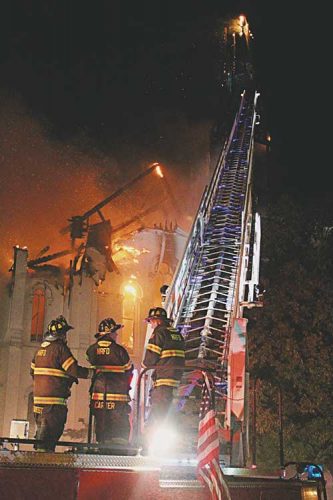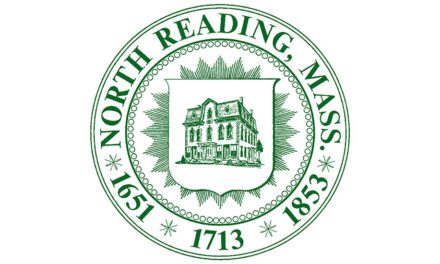150-year-old Wakefield church destroyed after lightning strike
Published in the October 25, 2018 edition
By BOB BURGESS,
MARK SARDELLA and
MAUREEN DOHERTY
WAKEFIELD — The stately First Baptist Church, a house of worship for generations, home to a nursery school educating hundreds of children over the years and an important part of a classic New England downtown, was destroyed in a massive fire Tuesday night set off by a lightning strike.
Wakefield Fire Chief Michael Sullivan said that a thunder storm came through town at about 7 p.m., and immediately on the heels of a couple of lightning strikes, the Fire Department started receiving calls reporting that the church had been hit. Shortly thereafter, the church’s fire alarm system went off and sent a signal to the fire station.

ICONIC LOSS. Struck by lightning during a brief yet intense storm Tuesday night, the 150-year-old First Baptist Church in Wakefield was no match for the fury of these flames. (Maureen Doherty Photo)
Sullivan said that the first arriving Wakefield crew, led by Wakefield Captain Paul Pronco, could see flames near the base of the steeple. They immediately started hitting that area with water and were preparing to bring a hose inside the church when the fire suddenly raced up the entire height of the 180-foot steeple.
Captain Pronco quickly sounded a second alarm and then a third, in what ultimately became a seven-alarm fire.
“No stopping it.”
Once a steeple is involved, Sullivan said it is very hard to control a church fire. Older churches such as the First Baptist Church tend to have multiple ceilings, including decorative false ceilings with voids between the ceilings and the roof. Once the fire gets into that space, Sullivan said, a fire can easily gain a lot of headway before firefighters can even see it or get at it.
“There was just no stopping it once it got into that concealed ceiling space,” Sullivan said.
In short order, Sullivan noted, the entire roof of the church was on fire. He said that the dry wood of the nearly 150-year-old church burned ferociously, giving off a high level of radiant heat. The Artichokes restaurant building next door to the church was “steaming” from the heat, Sullivan said, and windows on that side of the building facing the church cracked. The vinyl siding on an out-building on the church property also melted from the heat.
Sullivan said that there were three or four hours of active burning before firefighters were able to get the fire under control, and they remained there all night and into Wednesday morning fighting hot spots.
27 pieces of apparatus used
Engines and ladder companies came from North Reading, Reading, Stoneham, Melrose, Saugus, Woburn, Lynnfield, Malden, Middleton, Burlington, Peabody, Winchester, Revere, Lynn, Danvers, Lexington and Salem. A total of 20 engines and seven ladder trucks were involved in fighting the fire. Wakefield firefighter Daniel Paglia came in for high praise for the way he calmly orchestrated the movement of those companies.
Sullivan called the church “a total loss. I don’t see how any part of the church could be saved.” He estimated the damage at least $1 million.
The church was not equipped with a sprinkler system, Sullivan said, noting that there had been no significant construction at the church in recent years that would have triggered the requirement to install sprinklers. Had there been sprinklers, Sullivan said, it might have slowed the flames somewhat but it still would have been a major fire due to the age of the church. Most churches in Wakefield do have sprinkler systems, he said.
More than 100 FF’s & several million gallons of water
Sullivan said that firefighters used over 15 hydrants in the downtown area, Yale Avenue, Church Street and North Avenue. The DPW boosted water pressure to the area to help get more water on the fire. More than 100 firefighters dumped several million gallons of water onto the fire.
There were no civilian casualties, Sullivan said, although several firefighters did sustain minor bumps and scrapes in the course of fighting the blaze. There was a group meeting in the church at the time the fire broke out, but all exited the building prior to firefighters’ arrival.
As of mid-morning Tuesday, a crane had arrived to dismantle what was left of the church steeple. Since the roof is entirely gone, there is nothing left to support the four walls, Sullivan said, speculating that the walls may have to be knocked down by the crane as well.
Sullivan said that he was listing lightning as the cause of the fire and added that given the circumstances the state Fire Marshal’s office appeared to be satisfied with that as the cause.
Captain Paul Pronco and his first-arriving crew did everything they could do, given what they encountered, Chief Sullivan said, adding that the mutual aid system once again proved its worth, noting that there was no way that a fire department in a town the size of Wakefield could have fought such a fire on its own.
Wakefield Deputy Police Chief Craig Calabrese said that police officers worked with the DPW to get streets blocked off in order to allow firefighters to do their job. Several other communities sent cruisers to help local police with what became a major traffic operation.
Flames crackled and early on burning embers were sent at least 200 feet up into the night sky. Smoke from the intense fire could be seen from nearby communities.
On Yale Avenue, people coming from a wake at the McDonald Funeral Home dodged burning pieces coming from the church. Other properties were also rained down upon by glowing ash.
Hundreds of on-lookers crowded onto Main Street in the Square, Common Street and Lafayette Street to watch the firefight and lament the loss of an iconic, century and a half old structure.
Church praises firefighters, community
Church representatives posted this statement on the First Baptist website:
“While we lost our historic building from a lightning strike this week, we praise Jesus that our church community was kept safe. A very big thank you to the many firefighters who did their jobs with excellence, and to the outpouring of support from the community.
“We know that we serve a God who specialized in restoring brokenness and who can bring beauty even from the ashes. So we move into the future with trust, hope, and gratitude.”
Nursery school “devastated” by the loss
The church was also home to the Tall Spire Nursery School, where hundreds of children began their education over the years.
“I just think of my fellow teachers, whose life’s work has been in that building with the kids from this community and the communities all around,” said Amy Burd, who teaches at the nursery school that operated from the church basement. “We’re all devastated.”
The last church fire in Wakefield was the one that destroyed the old St. Joseph church in 1977.

NORTH READING firefighters (from left): Tyler Samost, Kevin Carter and Brian Nash discuss their plan of attack for re-positioning Ladder 1 to direct the water where it’s most needed and continue attacking the blaze that destroyed the First Baptist Church in Wakefield Tuesday night. (Maureen Doherty Photo)
North Reading’s response
According to North Reading Fire Chief Don Stats, he and the duty crew of Captain Eric Pepper and firefighters Kevin Carter, Brian Nash and Tyler Samost responded to the fire on the second alarm at approximately 7 p.m.
“The duty crew responded in Ladder 1, which is a rear-mount 105-foot aerial with a pre-piped waterway,” Stats said.
“On the third alarm, our Engine 2, staffed with Captain Matt Carroll and firefighters Jon Burt, Jeff Carey and Jim Norkum, responded to Wakefield to cover their headquarters and was quickly diverted to the fire just prior to reaching Wakefield headquarters, as the fire continued to grow and additional alarms were struck,” the chief recalled.
Stats praised his men for their actions at the scene, where the fire eventually grew to seven alarms.
“All North Reading fire personnel operated quickly and efficiently in responding to and operating at the scene. I am proud of the calm, professional manner the men displayed at such a dangerous, chaotic event,” he said.
Using all of its 105 feet, the Ladder 1 crew, which set up in the street directly in front of the church, provided the highest level of attack to knock down the raging fire that consumed the 180-foot iconic steeple and everything beneath it.
Stats assisted in directing resources and delivery of water from hydrants that kept the water flowing to both Ladder 1 and several Blitz guns.
Because the buildings surrounding the church were also in danger from the flying embers these Blitz guns were used “to prevent the Artichokes building from catching fire and the buildings behind it,” he said. Artichokes is a restaurant next door to the church.
Town can “take comfort” in robust mutual aid system
“The fire went to seven alarms, with a total of 12 mutual aid communities working closely together to mitigate the event. All 12 communities worked seamlessly together in one concerted effort and that is also something the citizens of North Reading and all those communities should be proud of,” Stats said.
Stats further noted that all residents can “take comfort knowing that not only is the North Reading Fire Department committed, ready and prepared but we, and all of our neighboring communities, enjoy the support of such an efficient and robust mutual aid network.”
North Reading Car 1, Engine 2 and Ladder 1 returned to North Reading at approximately 2 a.m., Stats said.




